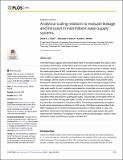Analytical scaling relations to evaluate leakage and intrusion in intermittent water supply systems
Author(s)
Taylor, David Donald James; Slocum, Alexander H; Whittle, Andrew
Downloadjournal.pone.0196887.pdf (8.448Mb)
PUBLISHER_CC
Publisher with Creative Commons License
Creative Commons Attribution
Terms of use
Metadata
Show full item recordAbstract
Intermittent water supplies (IWS) deliver piped water to one billion people; this water is often microbially contaminated. Contaminants that accumulate while IWS are depressurized are flushed into customers’ homes when these systems become pressurized. In addition, during the steady-state phase of IWS, contaminants from higher-pressure sources (e.g., sewers) may continue to intrude where pipe pressure is low. To guide the operation and improvement of IWS, this paper proposes an analytic model relating supply pressure, supply duration, leakage, and the volume of intruded, potentially-contaminated, fluids present during flushing and steady-state. The proposed model suggests that increasing the supply duration may improve water quality during the flushing phase, but decrease the subsequent steady-state water quality. As such, regulators and academics should take more care in reporting if water quality samples are taken during flushing or steady-state operational conditions. Pipe leakage increases with increased supply pressure and/or duration. We propose using an equivalent orifice area (EOA) to quantify pipe quality. This provides a more stable metric for regulators and utilities tracking pipe repairs. Finally, we show that the volume of intruded fluid decreases in proportion to reductions in EOA. The proposed relationships are applied to self-reported performance indicators for IWS serving 108 million people described in the IBNET database and in the Benchmarking and Data Book of Water Utilities in India. This application shows that current high-pressure, continuous water supply targets will require extensive EOA reductions. For example, in order to achieve national targets, utilities in India will need to reduce their EOA by a median of at least 90%.
Date issued
2018-05Department
Massachusetts Institute of Technology. Department of Civil and Environmental Engineering; Massachusetts Institute of Technology. Department of Mechanical EngineeringJournal
PLOS ONE
Publisher
Public Library of Science
Citation
Taylor, David D. J., Alexander H. Slocum, and Andrew J. Whittle. “Analytical Scaling Relations to Evaluate Leakage and Intrusion in Intermittent Water Supply Systems.” Edited by Zhi Zhou. PLOS ONE 13, no. 5 (May 18, 2018): e0196887.
Version: Final published version
ISSN
1932-6203